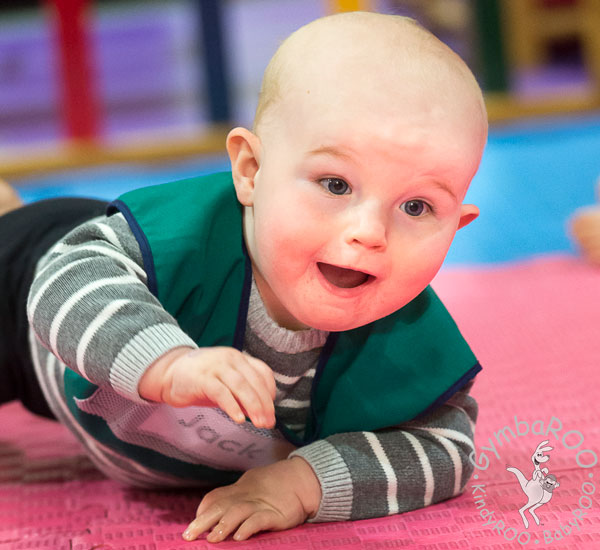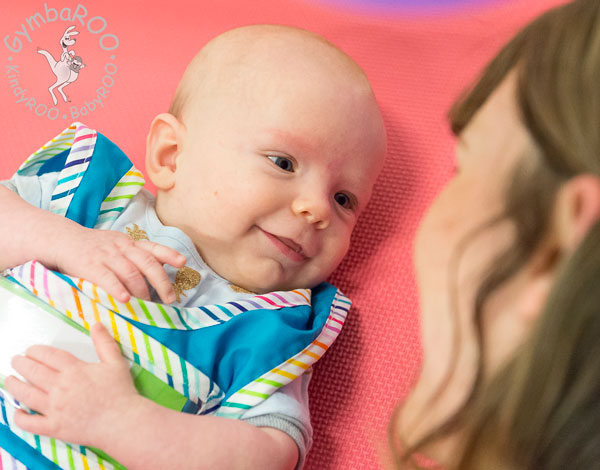Join the thousands of parents already raising smarter, happier babies with our online baby classes: The Active Babies Smart Kids series. Click here.
GymbaROO-KindyROO kids are excelling academically, emotionally, in leadership roles and on the sporting field. Find us at: GymbaROO-KindyROO
1. When do I start tummy time and how much tummy time does my baby need?
Tummy time can be started from birth and should be done every day! At GymbaROO, we can’t emphasise enough just how important tummy time is for your baby’s healthy development. Lie your baby on her tummy for several short periods of time each day while she is awake and then extend this time as she gets stronger. You will find that once she is strong enough, she will prefer to spend most of her waking day on her tummy. There are many ways to develop a love of tummy time together and the earlier you start, the better.
More:
- GymbaROO’s free online video – Tummy time: Information and activities.
- Tummy time for baby’s healthy development.
- My baby doesn’t enjoy tummy time. What should I do?
- The case FOR tummy time… something to send to anyone who tries to tell you tummy time is not important.
2. When should my baby be sitting?
Do not be in a hurry for your baby to sit. Developmentally, sitting is much, much less important than tummy time.
In the normal sequence development, it is at approximately the same time that a baby gets himself onto his hands and knees ready to creep (crawl), that he will push himself back to sit. A baby should not be sitting before this, as this is when brain and body are ready and he has developed adequate muscle and balance control. Sitting earlier than this can interfere with your baby’s natural progression of skills, each of which plays an important role in later learning and development. Sitting early, generally results in less tummy time (totally not ideal), and can also lead to bottom shuffling instead of the important movements of crawling and creeping.
More:
- Please don’t sit me until I can do it myself.
- ‘Baby Seat’ devices like ‘the Bumbo’ and propping your baby to sit. Please avoid.
3. When should my baby be crawling / creeping?
Babies are ‘crawling’ when they move around using the commando style tummy crawl. ‘Creeping’ begins when they lift their tummies off the floor and move around on their hands and knees. Here’s the thing, it is not so important when both these movements start, but that they do.
The age babies begin to crawl varies considerably, and depends on the child and the environment, however generally babies will start to crawl anywhere from 6 – 10 months of age and should crawl and creep for approximately 3 – 4 months or more, not less!
A really important fact – the longer your baby crawls and creeps, the better! Crawling and creeping provide strong neurological foundations for many of the skills needed for later learning and give your baby what she needs to get the very best start to life.
More:
- GymbaROO’s online video – Crawling and creeping: Information and activities.
- Why creeping and crawling matter.
- Crawling and creeping: Developing the skills for posture and balance.
- What if my baby didn’t crawl?
- What if my baby bottom shuffles?
4. My baby is standing up holding onto furniture, is he about to walk?
No, this is called ‘cruising’. A little after your baby starts to creep on all fours, he also learns to walk or ‘cruise’ around the furniture, holding on. Your baby will cruise and creep for approximately 4 months. While cruising helps to provide practice at learning to balance while in the upright position, it’s creeping that is the most important movement to encourage at this stage, so be sure that your furniture isn’t arranged so that your baby can cruise around the whole room!

5. When should my baby be walking?
Just like sitting, there is no need to be in a hurry for your baby to walk. As you’ll hear us say repeatedly at GymbaROO – “…it is not how early a child walks, but how much is learnt before walking that will influence the development of physical, social and academic well-being.”
Indeed, it is the milestone journey prior to walking that provides essential motor experiences that stimulate key areas of the brain important for later development, thinking and learning. Babies who crawl and creep before walking, have the best chance of developing to their full potential in school and in life.
More:
6. When should my baby be talking?
Learning to talk begins from birth and maybe even before. Babies will start to understand language, long before they can use it. Understanding speech and speech sounds is one step ahead of talking.
Sounds and words are learnt by being heard constantly. It has been said that babies need to hear a sound approximately 300 times a day for 300 days before they can say it. Which would explain why first words generally come at around the same time as your baby’s first birthday.
More:
- GymbaROO’s online video – Your baby’s speech and hearing: Information and activities.
- Baby’s speech development: What you need to know.
- Sing, talk and dance during pregnancy: It boosts your baby’s brain growth.
A further word about baby milestones
Developmental milestones are part of the screening process used by health professionals to determine if a baby is ‘on track’ in their physical and neurological growth. While there are established ‘normal time frames’ within which milestones are expected to occur, it does not matter at what point within the time frame that milestones occur, only that they do. Of course, you need to seek advice from your local health professional if your baby does not achieve milestones within these time frames.
More:
Bindy Cummings is a teacher, and early childhood neurodevelopmental consultant and early childhood development lecturer. She is the Editor of GymbaROO’s ‘First Steps’ magazine and online content, and the co-creator of GymbaROO’s Active Babies Smart Kids series. More on Bindy Cummings here.
GymbaROO Images by Studio Z Photography
Active Babies Smart Kids – Online Baby Classes
GymbaROO-KindyROO’s online series of baby classes is taking the parenting world by storm! It is highly recommended by doctors, paediatricians, early childhood experts and the Maternal Child and Family Health Nurses Association. This series is being called: “The essential guide for parents”. Join the thousands of parents already playing with their babies from birth, in the best way for brain and body development and laying crucial foundations for future learning. What happens in the first year, not only matters, it matters a lot! Enjoy the introductory video below.
Click here: Active Babies Smart Kids online series of baby classes
Try the first episode FREE: Tummy time + baby fun and development class 1
GymbaROO-KindyROO
Thousands of parents, babies and children are presently involved in our programs and creating rising stars. GymbaROO-KindyROO kids are excelling academically, emotionally, in leadership roles and on the sporting field. Come join all the fun and learning! “GymbaROO – The best decision I ever made for my child.” Classes from 6 weeks old – 7 years GymbaROO KindyROO
Enjoy the following GymbaROO-KindyROO articles
GymbaROO-KindyROO: Who, what, where, why and how
All about GymbaROO-KindyROO’s online baby classes for parents and babies: Active Babies Smart Kids




